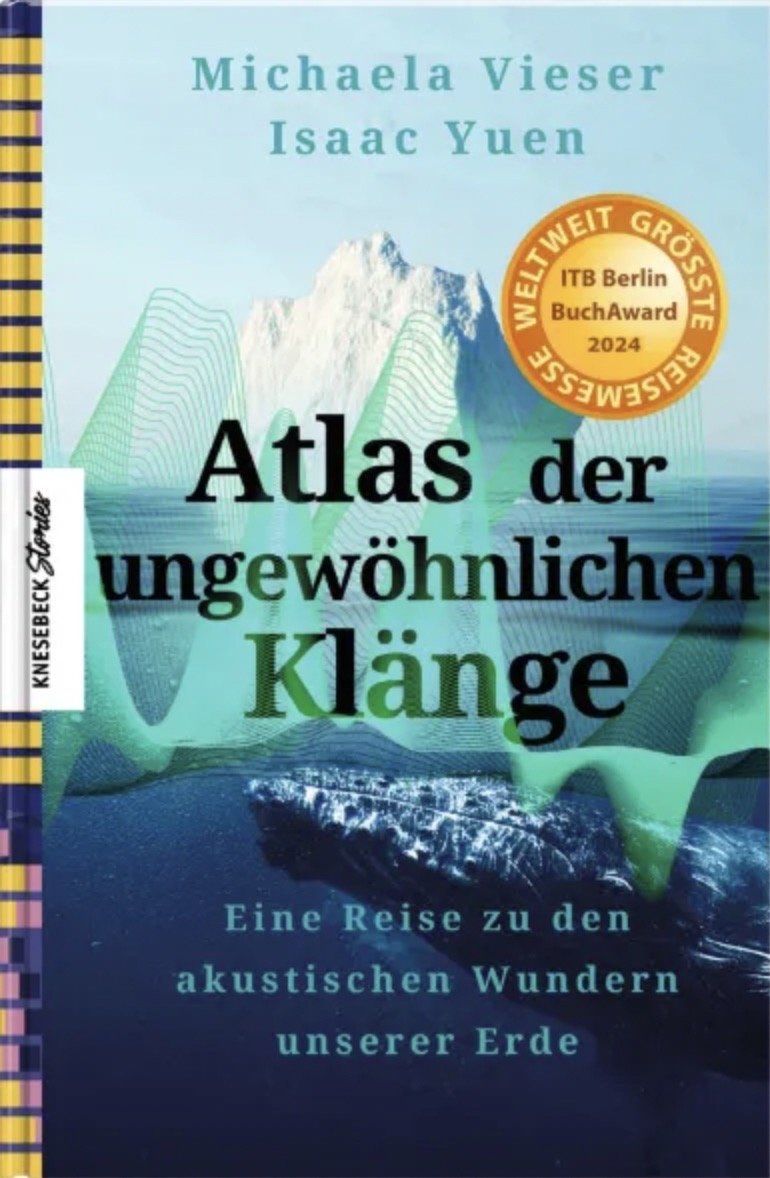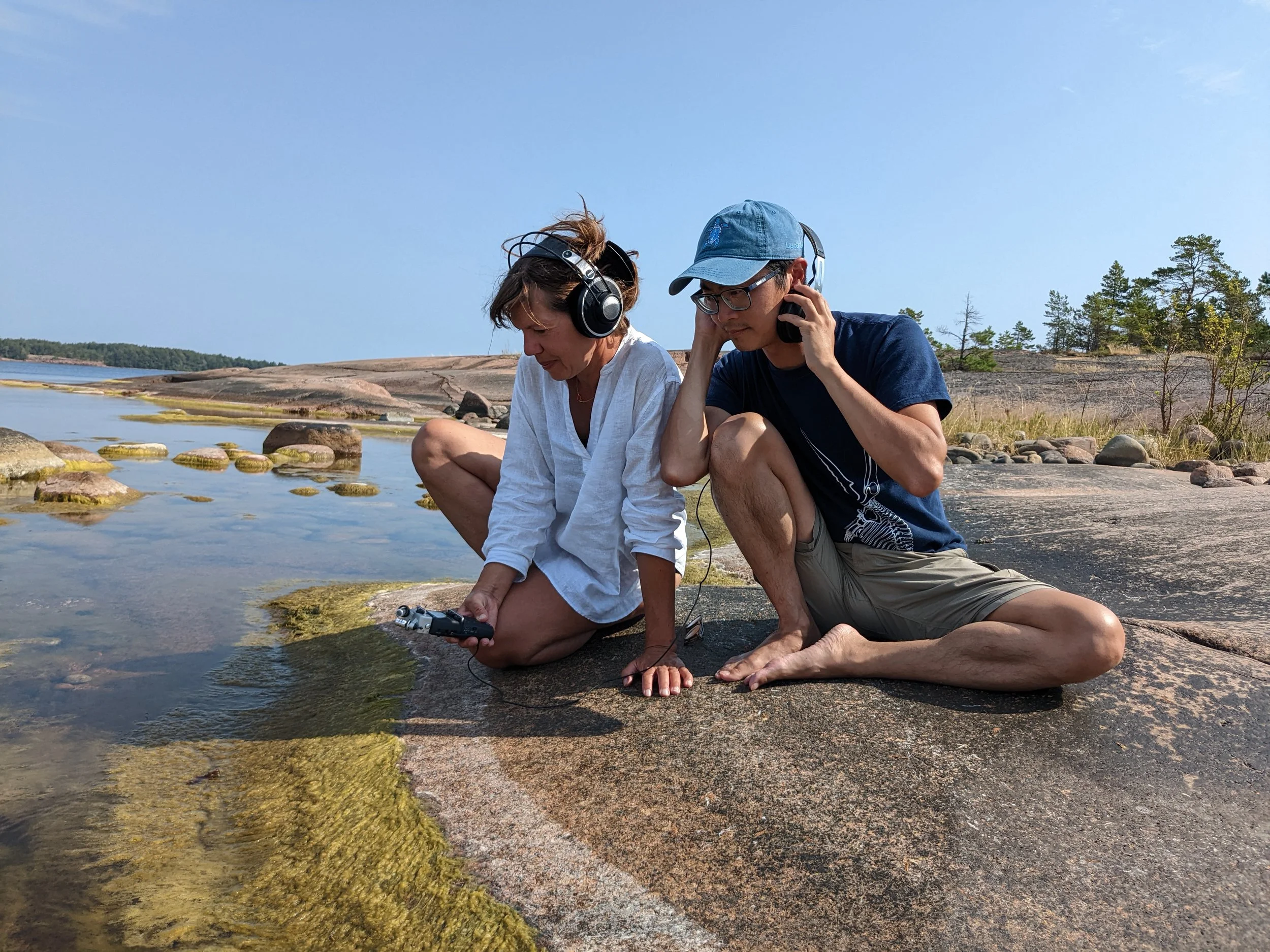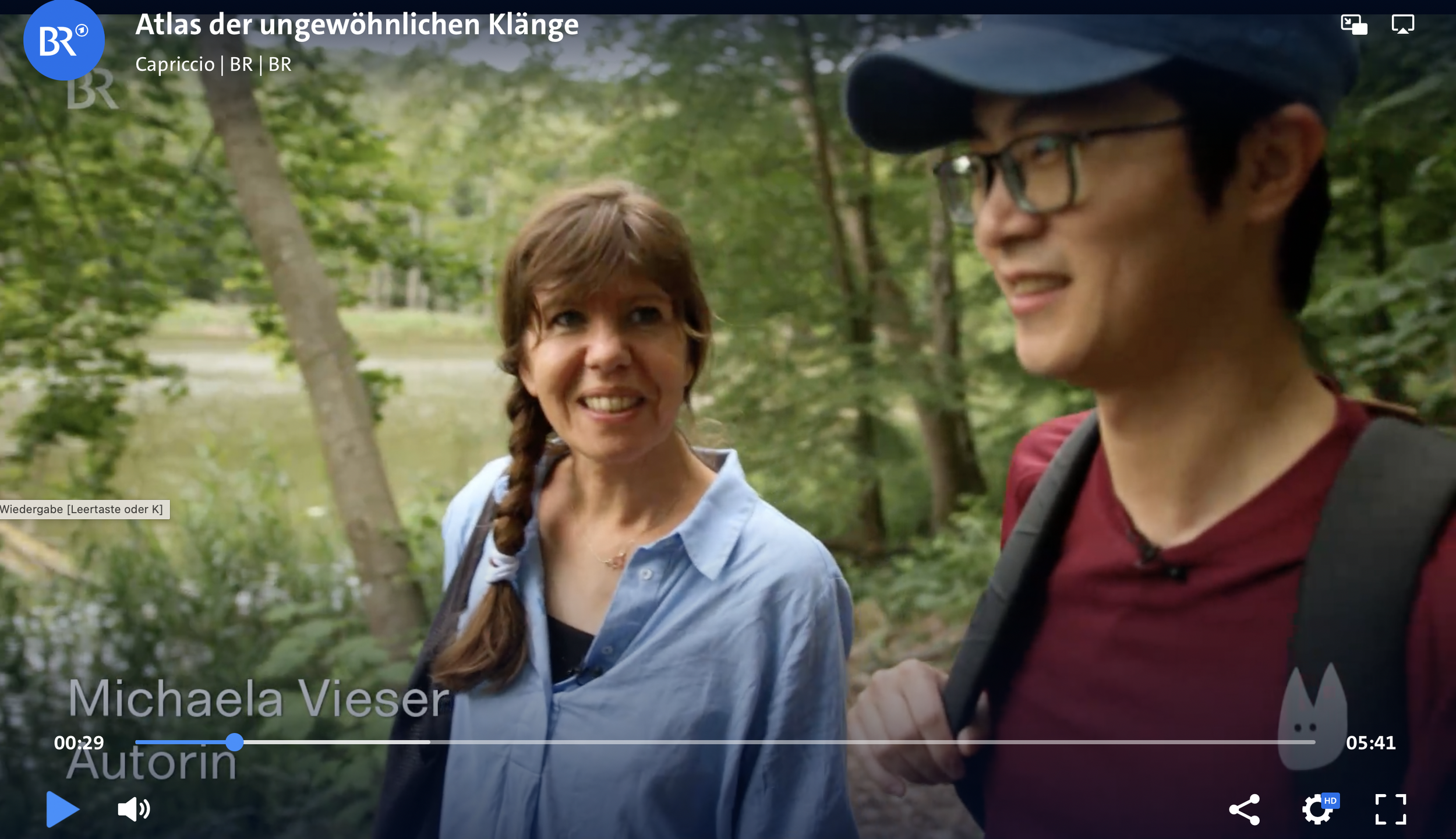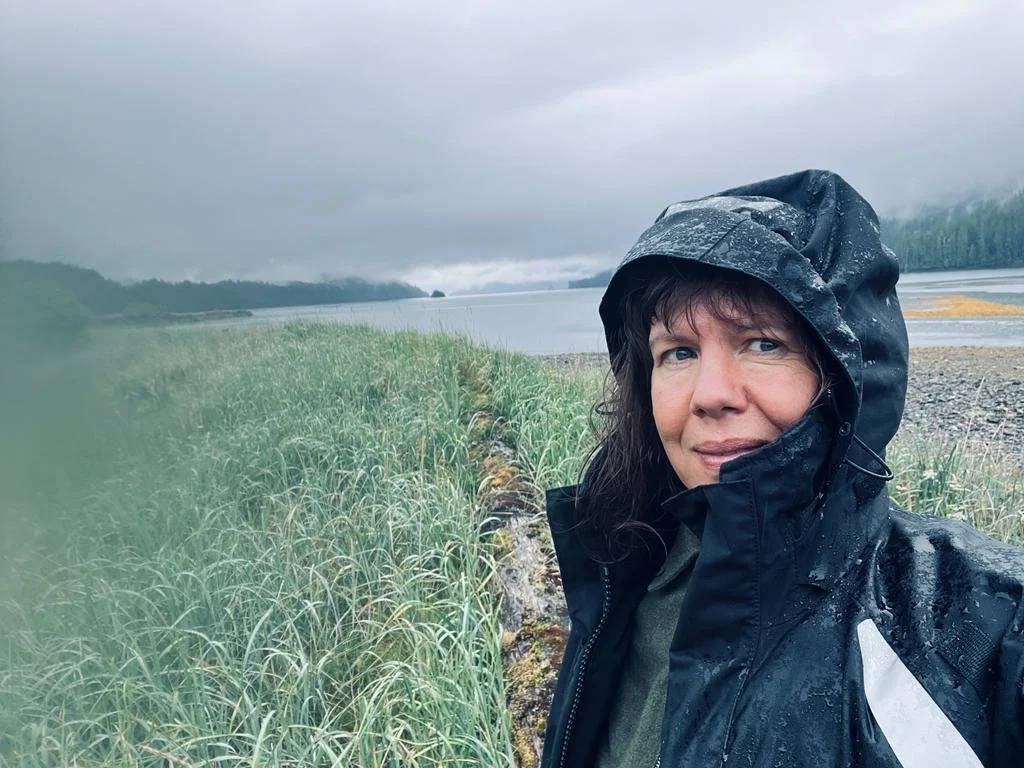The Sound Atlas - A Guide to Strange Sounds Across Landscapes and Imagination/ with Isaac Yuen/Reaktion Books September 2025
Explores the profound, cultural significance of sounds, blending history, science and personal reflection.
Nature writers Michaela Vieser and Isaac Yuen set out in search of sounds beautiful and loathsome, melodious and disturbing, healing, strange and intimate. The phenomena of sound may be fleeting and evanescent, but the memory of it can open a window into the soul, deepening our connections with time, the environment and each other. From the edge of the solar system to the crackle of arctic sea ice, from the ancient oracle site of Dodona to the singing pillars of Hampi, each of these thirty-six essays explores stories of sound through the lens of history, science and culture, stylishly blending fantastical facts and unique anecdotes to create a compelling narrative.
A sonic revolution is underway. The expanding field of acoustics is enabling us to tune into a multitude of invisible worlds. Scientists can transform energy transmissions from distant galaxies into audible harmonics. Sound artists use vibration sensors to help us probe into the deepest parts of the world. Hydrophones are revealing the vibrant chatter of the underwater world. But with this newfound ability to eavesdrop into new acoustic realms comes a responsibility not only to understand, but to protect them, sometimes from ourselves.
With the onset of the Anthropocene, humanity has unintentionally shaped new soundscapes while obliterating others. We have introduced noise and chaos into where once there was silence, and we have extinguished what once there was rhythm, melody, and harmony. We feel these losses also with our bodies.
Winner Best Literary Travelbook/ ITB Nominated Best Entertaining Science Book/ Spektrum der Wissenschaft 2023
“Cartography for the ears.”
“An extraordinary idea.”
”A silent, meditative book.” Oliver Schwesig,”
“This also includes sounds that are virtually extinct. This is a logical addition to Michaela Vieser's oeuvre, as her books and articles often deal with transience and ideas that are in danger of disappearing.”
Frauke Oppenberg, SWR2/ Tandem
The Revolution of Sound!
Yvonne Buchwald, German Aerospace Center
For news on the forthcoming English edition please write to Books
Interviews and Press Materials for the Soundatlas
Weather - Between The Dog Days Of Summer And The Twelve Nights of Winter.
Duden 2020
30 Essays on the atmosphere, weather phenomena and how we perceive them.
Why does Charles Dickens love mud, Hermann Hesse ice-skating and Cormac McCarthy weathering? What did Goethe write about the clouds? And what significance does the world of fog have in ancient Icelandic mythology? Weather and climate are among the most topical issues of our time. But language and literature are the oldest ways for us today to understand how we as a species have lived with weather.
Excerpts:
Eye of the storm: ‘Probably the most constant weather phenomenon in our solar system is raging on Jupiter: for at least 360 years, an anticyclone has been spinning above the planet, a hurricane of gigantic proportions, triggered by an area of high pressure. In the process, ammonia ice, ammonium hydrogen sulphide, water ice and vapour are whirled through space. The noise must be deafening - the sound waves measured are comparable to the brute noise of breaking ocean waves. This so-called Great Red Spot has a gigantic storm eye and, as with all storm eyes, there is no movement in the centre Silence. Silence. Nothing. A non-place in the midst of chaos, where time and space swirl around each other, charged and decelerated, whipped up and motionless, an oversized Tao.’
On the fallow light of winter: “It is an old word, this fallow. In its Anglo-Saxon original form fealwe, appears in one of the earliest poems in England: In The Wanderer from the 10th century anthology of poetry The Exeter Book, where the poem itself seems to date back even further. Here a lonely exiled man describes the winter landscape at sea, bathed in pale light, while in his inner eye he conjures up images of his missing tribal lord, his comrades by the warm fire, his tribe, all of whom he has lost in battle. Alone he is on his way, alone he must live on. Pale as a contrast to the memories, which are more vivid than his reality.”
Nominated Best German Science Book/ Spektrum der Wissenschaft 2020/2021
Everyone talks about the weather, unfortunately not very intelligently. With Michaela Vieser is a different story.
Mathias Kehle in Badische Nachrichten
A cultural history of the weather!
Mikael Krogerus, Das Magazin, Schweiz
Forever and Now. How to Celebrate Love Here and Elsewhere.
with illustrations by Irmela Schautz/ Kunstmann 2016
“Love is an action, never simply a feeling,” writes Bell Hooks. This book is an ode and at the same time a practical reminder of Love: while we often assume that marriage is the climax of our romantic love life, there are elsewhere rituals and traditions that pick other times and situations to manifest ones affection for another. This book combines some of the most beautiful love customs from around the world: entertainingly described, meticulously researched and wonderfully illustrated. In Wales, people devoutly carve and give away a love spoon decorated with a wealth of symbols; in the Rhineland, the desired woman is auctioned off at the May Marriage - or in Japan, at the Kanamari Matsuri, an astonishingly blunt celebration of male sexuality takes place, in which huge phallic representations are paraded ... There are poetic, funny, strange, crazy and enchanting customs related to love. They tell us what love can mean and how many different facets this ‘great feeling’ has. For readers in love, the book also contains ideas on how to put some customs into practice and provides suitable recipes for exuberant or intimate celebrations of love ...
Selected by the German Booksellers' Guild as their present to the Federal President of Germany on World Book Day 2017
‘If you find it difficult to talk about love, you'd better gift the book “Forever and Now”.
FAZ
“You can run to your favourite florist on Valentine's Day. But you could also seek inspiration from ‘Forever and now’.”
Stern
‘The best thing about Valentine's Day (...) are sometimes the books that are created with it in mind. One of these works has been published by Kunstmann Verlag, written by Michaela Vieser and illustrated by Irmela Schautz. Für immer und jetzt is a tender and wild mixture - a surprising gem among books - and an instructive compendium about where and how love is expressed worldwide.’
Der Standard, Österreich
"Admittedly, I haven't given much thought to the AbaGusii people in western Kenya. A huge mistake. Which I I realised when I read the book ‘Forever and Now’ by Michaela Vieser and Irmela Schautz.“
Uwe Wittstock, Focus Magazine
“Michaela Vieser describes these and many more comical, romantic or even absurd customs in a well-founded and witty way.“
Katharina Hesse, Börsenblatt
Of Coffee -Smellers, Privy-Providers And Fish-Bone Cutters - Professions From Bygone Days.
With Illustrations By Irmela Schautz/ Bertelsmann 2010
Nominated as Best Audio Book by Ohrkanu, 2011
Marble picker, everything-swallowers, armchair porters: Michaela Vieser has researched over two dozen forgotten professions and compiled some astonishing facts. The result is a short, sometimes bizarre cultural history of labour that takes us to medieval inns, Bavarian forests and Berlin backyards - written in a highly informative and entertaining way and illustrated by Irmela Schautz with original illustrations.
Translated into Japanese, Korean and Czech.
A sensual cultural history!
Der Spiegel
The book ‘Von Kaffeeriechern, Abtrittanbietern und Fischbeinreißern’ is the ideal case of a popular historical work: an enchanting journey through time, written in a knowledgeable and exciting way. Thus the profession of the non-fiction author is not threatened with extinction.
Hessischer Rundfunk HR4
Author Michaela Vieser and illustrator Irmela Schautz have spent two years researching, searching through archives, novels and paintings with a detective's instinct to track down extinct professions. And to the delight of all those who are now benefiting from it, they have made a find. The result is a highly entertaining and informative book that not only tells the story of the work itself, but also a lot of the ‘trappings’.
Swabian newspaper
And so this book tells the story of the growth and decline of the trades and thus of a piece of everyday culture beyond the history books.
RBB
Tea With Buddha. My Year in A Japanese Monastery.
Pendo 2009
When Michaela Vieser arrives at a Japanese monastery in a roundabout way, Buddhism is nothing more than a buzzword for her. She stays with the monks for a year, accompanying them in their spiritual and secular daily lives - and is a different person afterwards. However, she has retained her marvellously profane look, her twinkle in her eye. Witty, profound, personal: a journey of discovery into another world that touches us deeply in all its strangeness. Michaela Vieser actually wanted to study in Tokyo, but instead she ends up in a Buddhist monastery in the south of the country. She is the first Westerner to be allowed to share in the spirituality and tradition of this monastery. She sings and prays with the monks and is initiated into the secrets of the tea ceremony, sword fighting and calligraphy. Be it the mountain ascetic or the Zen monk singing karaoke - her encounters with fascinating people reveal to her the land behind the smile. An emotional journey to the spirituality of Japan, told realistically, with an eye for detail and a good dose of self-irony.
Spiegel Bestseller
She specialises in the unfamiliar. Where others remain on the surface, author Michaela Vieser delves deep into foreign cultures and times. What she brings to light are bizarre everyday stories and historical facts that go beyond the history books.
Deutsche Welle
A journey of discovery into the land behind the smile.
Kieler Nachrichten
Michaela Vieser takes the reader on an amusing journey into a foreign culture and makes it clear what you can learn from it.
BNN
Old crafts. On the disappearance of labour.
Edition Braus, 2013
Clockmaker, rollmops, confectioners and assembly workers: over a hundred photographs from the treasures of the bpk - Bildarchiv Preußischer Kulturbesitz, some of which have never been published before, show working environments that bear witness to a time when computers did not yet dominate the workshops. The working conditions of craftsmen, labourers, day labourers and other breadwinners are depicted here in authentic detail, taken by photography icons such as Willy Römer and Friedrich Seidenstücker, but also by lesser-known contemporary witnesses. These treasures in black and white bring to life a time when even machine labour was still manual work.
The strained gaze of a blacksmith, a weaver immersed in her work: a photo book shows pictures of old, partly vanished trades.
Die Zeit / online
The author rummaged through the photo archive for three months. She found photos of people carving clogs and walking sticks, sewing footballs, cutting corks and making candles. Pictures from a time ‘when even the machines were still manual labour’, as Vieser says. 600 photos were shortlisted. 150 made it into her new book ‘Altes Handwerk. On the disappearance of labour’.
Spiegel Online
This book fills you with melancholy. Because it tells of a working world that has been irretrievably lost, but also because the pictures radiate a sense of calm, and the people a sense of dedication and self-confidence. These are moods and attitudes that have become rare in today's working world of multitasking and screen work.
Susanne Lenz, Berliner Zeitung
The Age Of Machines - On The Industrialisation Of Life
Edition Braus, 2014
Tens of thousands of kilometres of railway lines, smoking factory chimneys in the cities, speculation on the stock exchange and light bulbs instead of candles in homes. During the period of the Kaiserreich, Germany experienced the transition to a modern industrialised society, accompanied by massive social changes. Housing, education, work and culture - all areas of life were subject to profound changes. Spectacular photographs from the treasure trove of the bpk - picture agency for art, culture and history document the awakening and transformation of the period in which the foundations of our modern world were established.
When machines became powerful: terrifying, instrumental, but above all life-changing. Great photographic book in black and white!
PM Magazine
Overlooked Sights. German Places. Roadbook.
With Reto Wettach/ IC Berlin, 2004
A Ritter Kahlbutz that doesn't decompose, a museum of lies that removes the dust of the ordinary from the stars and 65 other overlooked sights in Germany.
A richly illustrated, bilingual road book to unknown or forgotten places. Based on an epic 6 months tour in a VW camper van through Germany.
A terrible piece of work! Who likes to be reminded that they have spent their whole life travelling blindly through their own country? And that Germany is not dull and transparent at all, but mysteriously shimmering and beautiful - just like this book?
Tillmann Prüfer, Financial Times Germany
Beyond the tourist attractions, the magic is hidden in the little things.
Die Zeit
Übersehene Sehenswürdigkeiten’ is an exciting and original travel guide that shows Germany in a different light: as a romantic, magical and somewhat strange region, through which - especially at night - undead knights, eight-legged hares and two-headed calves roam freely.
Jan Brandt, Spiegel Online

















